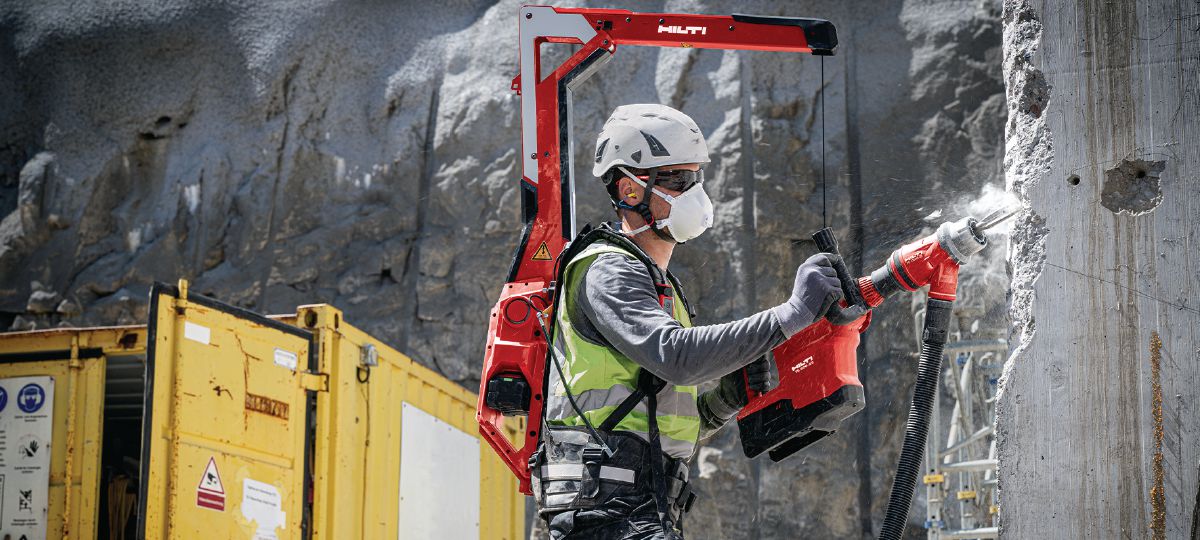The Top 10 Upcoming Sci-Fi Advancements in PPE
by Steve Dixon, HR and H&S Advisor
02-10-2025
Remember on Back to the Future 2 when Marty McFly’s shoes and jacket automatically tighten themselves to fit? In the late 80’s this was peak science fiction and inspired by expectations of the distant future, the year…. 2015.
Well, 2015 has been and gone, and we still don’t have robotic clothing… but the reality could be closer than we think. Imagine respirator masks that tighten their own seals, helmets that monitor the wearer’s surroundings and whisper warnings in their ears or materials that ‘heal’ themselves after being damaged… science fiction right? Wrong – as you’re about to discover with...
The Top 10 Upcoming Sci-Fi Advancements in PPE:
1. Self-healing fabrics
Imagine ordering gloves for your staff which repair themselves as they wear out. There are fabrics entering the market with special polymers that literally ‘heal’ micro-cuts and scrapes. The dynamic chemical bonds of these materials can snap back into place at a microscopic level resulting in PPE that lasts longer. There are manufacturers in the USA, Europe and Asia with prototype applications in gloves, clothes and boots. The first products to the market could be available as early as next year with widespread adoption forecast by the end of the decade.
2. Liquid body armour
If you’re picturing the T-1000 from Terminator 2… not quite. Imagine clothing that flows like fabric yet hardens instantly the moment it’s struck. This technology uses shear-thickening fluids—suspensions of microscopic particles in a liquid that behave like quicksand in reverse (Like Oobleck or non-Newtonian fluid, if you’ve heard of those). Flexible and comfortable under normal conditions, the material stiffens on impact, spreading the force of a blow or stopping a blade in its tracks. Researchers in the US, Europe, and China are embedding these fluids into textiles, creating lightweight vests, sleeves, and even everyday uniforms that could replace bulkier Kevlar. Military and law enforcement are the first adopters, but the potential for industrial safety is vast. Prototypes are already in field trials, with more advanced versions expected to reach the market between 2026 and 2029.
3. Smart respirators
The humble dust mask is evolving… futuristic respirators currently in development come equipped with miniature sensors that constantly monitor airflow and pressure, detecting the faintest leaks that the wearer can’t perceive. If the seal weakens, the mask has the ability (and inclination) to tighten itself. Some models currently under development can feed exposure data to the wearer’s visor or handheld device, giving an instant read on protection levels. Research groups in Asia, Europe, and the US are already field-testing prototypes, with industries like healthcare, mining, and chemical handling marked as early adopters. Commercial rollout could arrive by 2026, turning the respirator from a passive filter into an active shield. Of course, even the smartest mask in the world can’t beat their eternal adversary: the beard—sorry, whiskered workers of the future, you’ll still need a positive pressure hood.
4. Self-charging nanofiber filters
It certainly sounds fancy… to appreciate what these are all about, you need to have an understanding of how conventional filters work (in a dust mask for example). They use mechanical blocking (like a sieve) and electrostatic attraction (charged fibers that “pull in” particles) to collect and attract unwelcome particles before they enter your airways. The status quo now is that new filters have a charge from the factory but become swiftly less efficient as that charge is dissipated, by moisture in your breath for example. Self-charging piezoelectric nanofiber filters however, seek to recharge their static electric power every time you breathe, talk, or move. Instead of filters gradually losing efficiency, these membranes keep pulling in microscopic dust, aerosols, or pathogens for far longer, while staying easy to breathe through. Some researchers are also experimenting with layering in antimicrobial or photocatalytic coatings, which can kill or deactivate trapped microbes, preventing them from building up live colonies. Disposal will still be required but the idea is that you need fewer replacements.
5. “Heat armour
For workers in blazing sun or sweltering industrial settings, the next wave of PPE isn’t just about shielding—it’s about climate control. There was a time where little could be done to combat a cold kiwi morning on the construction site, short of the obligatory free beanie from Bunnings – but now Milwaukee heated jackets with rechargeable battery packs are an everyday sight. Now scientists are applying this same creativity to the opposite climate, designing textiles that reflect away incoming sunlight, radiate excess body heat into the atmosphere, and buffer temperature spikes with embedded phase-change materials. These substances melt or solidify at skin-friendly thresholds, quietly soaking up heat when you’re hot and releasing it when you cool down, like an invisible air conditioner built into your clothing. Early international prototypes have shown measurable comfort gains for linesmen, firefighters, and agricultural crews operating in extreme heat. “Heat armour” could be the difference between a safe day’s work and heatstroke during summer on the Canterbury plains… keep an eye out for this tech in the coming years.
6. AR-Integrated safety helmets
Hard hats of the future may have more in common with Stormtrooper helmets than the upturned bargain-bin salad bowls we balance on our heads today. The newest prototypes provide traditional impact protection… but also feature Augmented Reality overlays, projecting hazard warnings, navigation cues, or equipment readouts directly onto a transparent visor. Imagine a helmet that highlights a reversing truck behind you, maps a safe path across a busy construction site, or whispers alerts about high-voltage lines overhead. The technology is already commonplace on the battlefield and in the aviation industry globally. VR and AR modules are used to simulate maintenance environments, walkarounds, and systems diagnostics — so the leap to full AR helmets is a logical next step. For the worker of the near future, a helmet won’t just protect your head— via Augmented Reality it will expand your awareness.
7. Industrial exoskeletons as ergonomic PPE
Avatar, Alien 2 (Aliens), Edge of Tomorrow, The Matrix, Pacific Rim… Iron Man. In Hollywood, it seems like every bugger is running around in a robotic suit! But this isn’t necessarily A vision of the future, it’s arriving in warehouses and workshops right now. Exoskeletons, both powered and passive, are designed to offload strain from the back, shoulders, and arms, giving workers extra support when lifting heavy loads or repeating awkward movements. Some models use lightweight carbon-fiber frames and spring-loaded joints to “store” energy as users bend, then release it when they stand. Others add powered actuators that can give a boost on command. Hilti Exoskeleton’s (Pictured above) are already available for purchase and in use on New Zealand construction sites. A range of manufacturers have products in pilot use on automotive assembly lines and logistics centres across the USA. These devices are rapidly becoming less like fancy robotics and more like every day PPE—just another tool in the safety kit to prevent injuries. While regulators are studying long-term impacts, adoption is expected to ramp up swiftly in the coming years. For many workers, the exosuit will become the new hard hat: standard issue.
8. Colour changing hazard sensing materials
Remember mood rings—the little trinkets that supposedly betrayed your teenage angst by turning black before math class? Now imagine that concept applied to PPE. New textiles infused with halochromic and photochromic dyes can literally change colour when exposed to acids, bases, UV radiation, or excess heat. Instead of waiting for a handheld sensor to beep, your shirt sleeve or vest could shift hue the moment invisible danger is in the air, giving you a clear, visual warning that something’s wrong. There are prototypes in existence which can be washed and re-worn, however durability seems to be the current hurdle. Industries like chemical labs, refineries, and hazmat response are obvious first adopters, with pilot garments expected to rollout in the next few years. But beware… if the future of this tech is applied to psychosocial hazard identification, an office mood vest could betray your true feelings towards your boss!
9. Self-disinfecting PPE
Imagine if your gloves and face shield could clean themselves, every time they caught the light? That’s the promise of photocatalytic coatings - special films infused with titanium dioxide or silver nanoparticles which, when exposed to UV or even indoor lighting, generate reactive oxygen species that kill microbes on contact. Instead of PPE becoming a slow breeding ground for bacteria and viruses, these surfaces stay hostile to germs, reducing the need for constant sanitising or frequent replacement. Research labs and coatings companies are already testing durable formulas that bond to textiles and plastics without washing away, with early versions applied to medical gowns, masks, and touch surfaces in hospitals. Wider adoption in healthcare, food processing, and transport could arrive as soon as 2026. In the near future, your safety gear won’t just block hazards - it’ll actively fight them off. The boffins will have their work cut out for them applying this tech to a teenager’s bedroom…
10. Smart hearing protection with situational awareness
If you have ever wielded a chainsaw then you know there is an international gesture to get an operator’s attention safely. Between ear protection and the screaming two stroke motor, you don’t sneak up and yell at a man with blades flying around on a chain… the industry standard for the past 100 years? throw a piece of bark at him. Traditional earmuffs and plugs protect the user’s hearing, but leave them cut off from the world - shouting at co-workers or missing warning sirens altogether. The new generation serves to flip that on its head. Smart hearing protectors use embedded microphones and digital filters to block the damaging stuff (sudden blasts & constant machinery roar) while letting through safe sounds like speech, alarms, or even birdsong. Some models layer on radios and Bluetooth comms so crews can coordinate without pulling off their gear. Military units have used versions of this technology for years, and it’s now trickling down into NZ construction, manufacturing, and mining via products like the 3M Pro-Protector. The tech is on the market now but expect it to get cheaper, sleeker, and more effective in times to come. Protecting your ears doesn’t mean tuning out the world in 2025… it might be time to holster the flying bark wads.
Look back 30 years and you would struggle to find a harness or a high-vis in your average New Zealand workplace. 20 years and you would be just starting to see cell phones, portable gas detectors and internet usage. 10 years ago, widespread GPS adoption, workplace defibrillators and drones were just coming on the scene. That’s how quickly the landscape shifts: what feels like science fiction now, can become tomorrow’s standard-issue kit. Self-healing gloves, exosuits that shrug off fatigue, helmets that whisper warnings - these aren’t just concepts, they’re the next step in a long march toward safer, smarter workplaces. The future of PPE isn’t arriving on the distant horizon. It’s already tightening its own straps, pulling on its hover-boots, and clocking in for the morning shift.
Water cooler chats just got more interesting…
Published 02/10/2025
From 27 August 2025, a new law: The Employee Remuneration Disclosure Act 2025, means employees are free to talk about...
Continue ReadingCutting Red Tape - NZ Health and Safety Law reforms
Published 04/09/2025
Politics. I know it’s not a popular topic. But if you’re a responsible business owner, one topic that sho...
Continue ReadingIt’s hard to kick goals with your feet in your mouth – the top 5 questions you can’t ask at work… that everyone does
Published 04/09/2025
Sometimes being a Human Resources (HR) professional is at odds with genuinely innocent human curiosity, as you’...
Continue Reading
